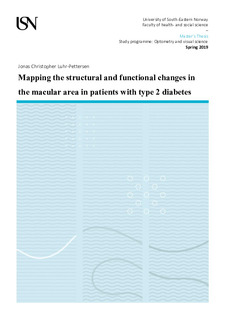| dc.description.abstract | Purpose: Diabetic retinopathy is one of the leading causes to blindness in the working population today. It can be detected, classified and followed up by optometrists through different optometric examinations. The primary purpose of this study is to investigate the clinical findings in patients with diabetes type 2 and mapping the retinal structural- and functional changes using the technique of retinal imaging, optical coherence tomography (OCT), automated perimetry, contrast sensitivity and measuring visual acuity. The secondary purpose is to investigate the effect of cataract on visual function in these patients.
Methods: This is a cross-sectional study with a prospective design. The test subjects were recruited from The Norwegian Diabetes Association in Buskerud, Telemark and Vestfold. Optometric practices in the same counties were contacted and asked if they could inform their patients that had type 2 diabetes about our study and give them our contact information. The recruitment took place from the period of august 2018 to January 2019. Data was collected from patient history and the test subjects underwent the following optometric tests; refraction, best corrected visual acuity, retinal sensitivity and contrast sensitivity, in addition to retinal imaging (photo and optical coherence tomography). Evaluation of sectors of 1q and 10q in diameter of the macular area was conducted as well with retinal imaging using fundus camera, and the central foveal thickness was measured with OCT. The number of retinal findings (microaneurysms, hard exudates, dot & blot hemorrhages and cotton wool spots) were correlated with the retinal sensitivity within the different sectors, and the central foveal thickness were compared with central 1q retinal sensitivity, the contrast sensitivity and with the best corrected visual acuity. Cataract were graded to look for effect on visual function.
Results: Linear regression were used to look for association between retinal findings and retinal sensitivity, and the same for association between central foveal thickness and central 1q retinal sensitivity, the contrast sensitivity and with the best corrected visual acuity. Independent sample t-test were used to look for association between cataract and visual function. The results indicated no statistical significance (p > 0.05 in all statistical analysis). The test result showed a tendency that the retinal sensitivity in the central 1 mm sector was affected by the central foveal thickness, but this was not significant.
Conclusion: Diabetic retinal features does not affect the retinal sensitivity. The central foveal thickness and its effect on visual function like contrast sensitivity or best corrected visual acuity showed no statistical significant relationship. The relationship between central retinal thickness and central retinal sensitivity may suggest that the central visual field might be affected. Presence of cataract has no correlated impact on the visual function in diabetic retinopathy regarding the contrast sensitivity neither the central retinal sensitivity in 1q of the visual field. | en_US |
